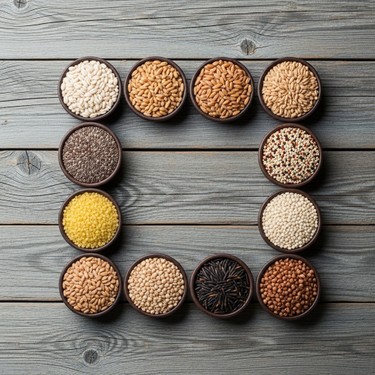Ancient Grains 101: 10 Super-Nutritious Staples That Are Making a Comeback




The best part? They’re not just history lessons in a bowl. Ancient grains are nutritional powerhouses tailor-made for modern cooking. We’re talking plant-based protein, gut-happy fiber, and minerals like iron and magnesium — all delivered with earthy, satisfying flavors and textures that make every bite feel like it’s doing something good for you.
And they’re ridiculously versatile. Gluten-free? Say hello to buckwheat, quinoa, and sorghum. Plant-based? Farro, spelt, and wild rice are your new best friends. Just looking to shake up your pasta-and-white-rice routine? Grab a bag, get cooking, and you’ll quickly see why these time-tested staples are making a seriously tasty comeback in kitchens everywhere.
Why they deserve a permanent pantry spot:
From the Incan mountains to your modern kitchen, these grains are proof that some culinary trends never go out of style.
Extra Tip: Batch cook – Make a big batch and refrigerate for quick salads, bowls, or breakfast porridge.
Quinoa is a well known pseudo grain which is believed to increase strength and stamina. Native to South America and cherished by the Inca civilization, quinoa is technically a seed — but it cooks like a grain. A complete protein, rich in iron and magnesium, and naturally gluten-free. It's a complete protein, a good source of dietary fiber and has the highest potassium count of all the whole grains. Not only is it healthy, but it also cooks in about fifteen minutes!
One of the oldest cultivated grains, popular with ancient Egyptians and Greeks. High in soluble fiber with a malty flavor. It's also rich in vitamins that help reduce the risk of heart disease.
Despite the name, buckwheat isn’t related to wheat at all. It’s a gluten-free seed rich in antioxidants and magnesium. Often called a “superfood,” buckwheat supports heart health, and can prevent diabetes and digestive disorders. Traditionally used in soba noodles and pancakes, buckwheat has a toasty, earthy taste.
Spelt has been around since 5,000 BC and was a key grain in early European farming.
It's a great source of fiber, protein, B vitamins and minerals like manganese. Spelt has a slightly sweet, nutty flavor and is often used in place of wheat flour for baking.
Popular in Middle Eastern cooking, bulgur is made from cracked wheat that’s partially pre-cooked—meaning it’s one of the fastest grains to prepare. It has more fiber than quinoa, oats, millet buckwheat or even corn. Bulgur has a light, nutty flavor and quick cooking time made it perfect for those just starting to explore cooking with grains.
Grown in Africa, India, and the U.S., sorghum is a naturally gluten-free grain with a neutral flavor and smooth texture. It's a gluten-free grain, rich in B vitamins, iron, manganese and fiber. It can be cooked like rice or popped like popcorn!
Technically a grass seed, wild rice has long been harvested by Native American communities in the Great Lakes region. A good source of dietary fiber, wild rice has almost double the protein in regular white rice as well as fifteen times the antioxidants. It’s chewy, nutty, and loaded with antioxidants and protein.
Used as food and medicine by the Aztecs, chia seeds are tiny but mighty. Just a spoonful delivers fiber, omega-3s, and plant protein. They help in weight loss, prevent diabetes and heart disease, and promote energy. When soaked, they form a pudding-like gel—perfect for snacks or breakfasts.
These chewy, nutty whole wheat kernels are minimally processed and full of fiber, protein, and vitamin E. It promotes healthy bones and muscles and can be ground up into whole wheat flour. They make a great base for grain salads or breakfast porridge.
This nutty grain from ancient Mesopotamia is the oldest cultivated grain in the world and is a staple in Italian kitchens. High in fiber, plant protein, and B vitamins, it adds a chewy texture to soups and salads. It is now being used in gourmet specialty dishes around the world.
Start by adding one or two to your pantry this week — your gut, brain, and taste buds will thank you.